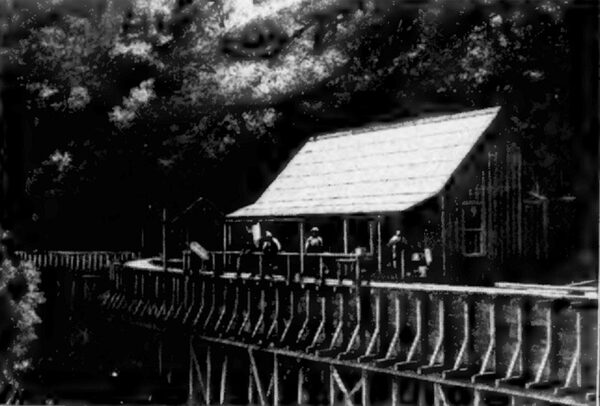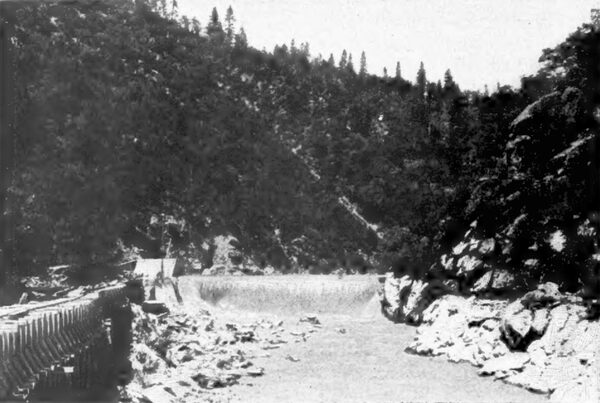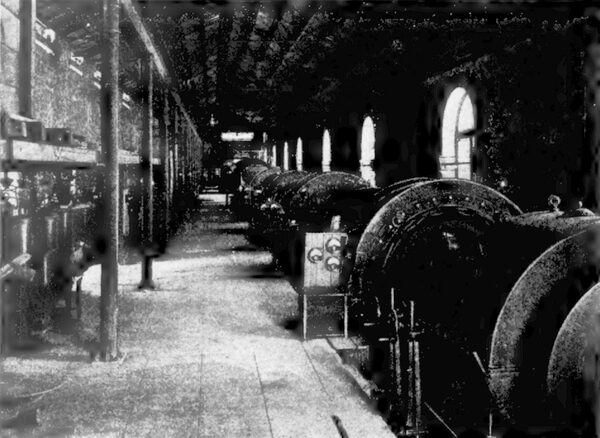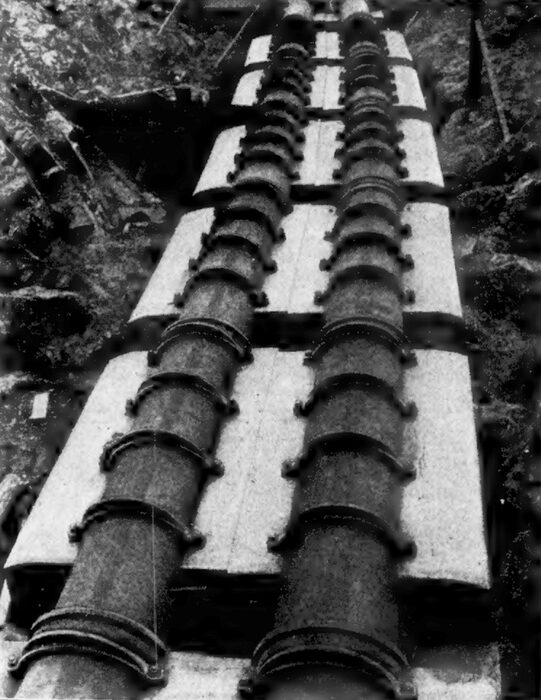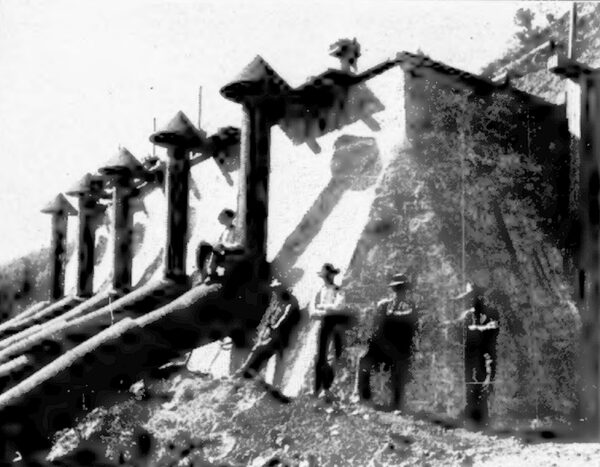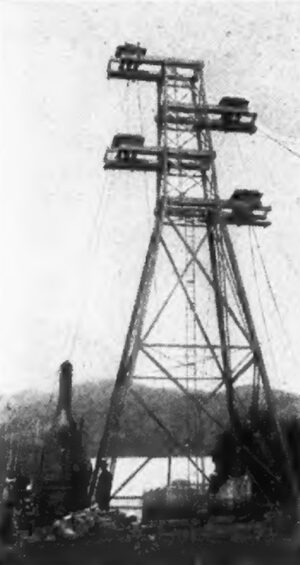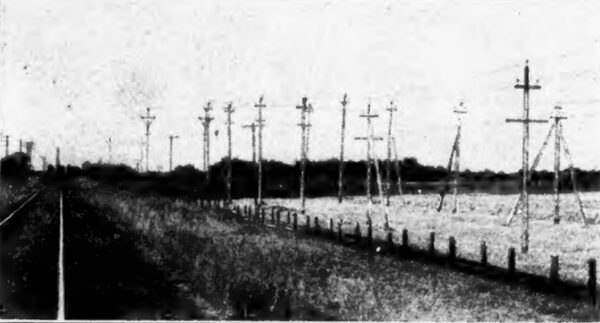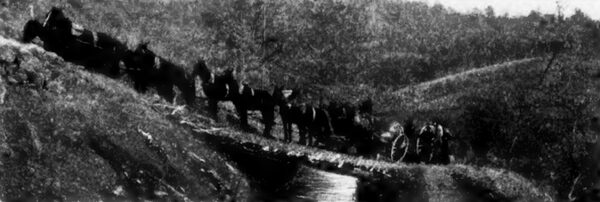[Trade Journal]
Publication: American Monthly Review Of Reviews
New York, NY, United States
vol. 25, no. 146, p. 305-311, col. 1-2
THE LONGEST TRANSMISSION LINE IN THE WORLD.
BY THOMAS COMMERFORD MARTIN.
THAT compensatory plan of Providence which gave England her coal beds in lieu of sunshine has endowed California with one of the brightest climates in the world but left her without resources of fuel. Whether it is better for a country to live on its geology or its geography has remained hitherto a moot question, but usually coal-mining regions have little to recommend them as places of residence after the de posits are exhausted. Newcastle and Pittsburg have no vogue as pleasure resorts; but long after their pits and volcanoes of pent-up energy, hushed and empty, lie in black silence, picturesque Switzerlands and Californias will be drawing cheerfully upon the renewed bounty of the daily blue sky and fleecy cloud. The chief future use of China appears to consist in its supply of black coal; but when that, in turn, is worked out, the melting glaciers of the Jungfrau, the bubbling streams of the snow-clad Sierras, and the rushing tide of the Niagara Gorge will still be here, to give up to us, not alone their beauty, but their strength. It is doubtless satisfactory to know that if you want warmth and light you can dig it up; but when the digging of the black coal dwindles, hand-to-mouth diurnal dependence upon sunshine and showers for the ‘‘white coal” that must largely take its place will be a mark of the highest economy and best efficiency on the part of our engineers.
| |||
| Bird’S-Eye View of the Bay Counties Power House, on the North Yuba River, Foothills of the Sierras, California. |
Anthracite, bitumen, wood, gas, and oil we are now burning up at a fine old rate, and once in a while we throw a little good food into our furnaces, also, to keep them going; but even today, in spite of the cheapness that such a reckless exploitation of combustibles involves, great water-power developments and transmissions have become established. Their success is already profoundly influencing many notable enterprises and some great regions, where all the conditions have been favorable but that of fuel supply. The plant in California to which this article is devoted is being studied and imitated at points widely remote from each other in the two hemispheres, and results promise that are somewhat novel. Typical of such work is that in Mysore, India, or even more so that proposed at ancient Phil, where the impounded waters of the Nile will submerge ancient temples of an out worn faith and make them sources of an illumination and culture quite other than were in the contemplation of the moldered priesthood. India as a center of factories; Egypt a leading cotton goods manufacturer; Switzerland, industrial heart of Europe; California and Chippewa sending out electric power for every wheel within five hundred miles,—these and other noteworthy changes impend as the age of long-distance power-transmission begins with the new century.
Somehow or other, California has ever been graced with the spacious air of brave adventure to the Kasterner and the European ; and thus this latest event in her history, the putting into operation of the longest power-transmission in the world, prosaic as it is in details, keeps gallant company with her romantic mission days, the brisker stirring and whip-cracking of stock rangers, the fierce excitement of her gold discoveries, the splendid broadening of her wheat-fields and orchards, the boldness of her irrigation ditches, and the princely magnitude of her unparalleled educational gifts. It must be something in the race, for where the Spaniard and the Mexican found the dreamy climate all too wooing to the ‘‘sweet doing of nothing” through the long afternoon of colonial existence, the strenuous Anglo-Saxon has pushed to every extreme of pioneership and achievement. A deadening Orient civilization be sets the California shore with the damp Pacific breezes that fret the cypresses of Monterey; but the waiting Sierras catch their moisture, and in an instant transmute it into that irresistible electric current which is the expressive essence of Occidental science and progress.
 |
For some years past, California has suffered in various respects from the dearness and absence of fuel; and the invitation to utilize some of the water power of her mountain ranges has always been urgent. The successful efforts at irrigation may be said to have led the way, and the State witnessed some of the earliest, attempts of electrical engineers to transmit energy over long distances on a commercial basis, so that it is nothing new for them to have their attention concentrated on that spot. But until quite recently, the limitations were rather severe. Obviously, except for mining, there would be little use of the current in the mountainous regions where it is generated; while, on the other hand, the cost and ‘‘loss” in the operation of the long lines that would put this energy beyond the pale of the foothills and within reach of the larger towns and coast cities were believed to be prohibitive. It is true that the great Niagara plant went into operation in the last decade, and, with all the lakes to draw upon as a reservoir, has been a pronounced success; but its present utility is within a striking distance of fifty miles. As late as September, 1896, Dr. Louis Duncan, a foremost authority, in his inaugural address as president of the American Institute of Electrical Engineers, remarked: “If we consider the record of the present plants, we can safely say that it would not be going outside the safe limit of development to transmit at least 50 miles at a potential of 20,000 volts.” Within five years, out in California, they have increased the distance four times and raised the pressure threefold,—a record that would be fairly respectable in any branch of industry, and establishes an excellent start for the second century, whose predecessor began with Volta and with his little battery. Now, a circle around Niagara of 50 miles radius would not mean much to Rochester or Toronto; but radii of 220 miles in every direction from the Colgate power plant on the North Yuba River would include a region bigger than England. As it is, the lines of the allied Bay Counties and Standard systems shown on the map herewith are already furnishing current for light, heat, power, chemical and metallurgical work, etc., in no fewer than sixteen counties of the State, within whose borders lie one-half the population and three-fifths of the assessed valuation. And this is not a temporary experiment like the 110-mile Frankfort-Lauffen of 1890, but a strictly commercial enterprise, attending to business all around the clock, every day in the year. Niagara also could, of course, send out its energy just as far, but industries and population at its very brink constantly intercept the supply, and apparently are basing upon it the nucleus of a vast productive city. This is, indeed, one of the most interesting power problems of the times. So far, none of the world’s greatest cities has been built upon the coal measures or at the waterfalls; and it remains to be seen whether in the long run the people will go to Niagara or whether Niagara must come to the people. In California, the problem is notably different, for the Sierras will always remain lonely, and San Francisco will always sit by the Golden Gate and multiply her children there.
| |||
| The 1,275-Foot Tramway for Lumber. (Used Temporarily in the Construction Work at Colgate.) |
The enterprise of the allied Bay Counties Power and Standard Electric companies has, in fact, more than one source of energy to draw upon; but it is rather with the plant at Colgate than that at Electra that we now deal, the Colgate development being so much more striking and significant, on account of the far, tentacular reach of its circuits.
If space permitted, it would be very interesting to note the manner in which the Standard Company, under Prince Poniatowski, consolidating earlier work, has pushed its plans, organized its forces, and developed the great enterprise. Even the fine new power plant at Electra is no fewer than 154 miles from San Francisco, and the work attendant on its construction and general connections into the system has been in progress for four years. This last month, Dr. F, A. C. Perrine, in a lecture before the New York Electrical Society upon his return from a professional investigation of the power-transmission conditions in California, characterized the Standard work as most notable for originality of conception, and for the rigidly careful manner in which every feature was being executed so as to secure permanence and continuity. It will be gathered from these remarks that very soon the Standard Company will have the two strings to its bow—Electra and Colgate.
| |||
| A Camp and Patrol Station Along the Flume of the Colgate Water Power. |
The latter plant is seated on the North Yuba River, on its north bank, at the crossing of the old Missouri Bar trail that Californian pioneers wot of so well. The panoramic view at the head of this article gives a good idea of the topography. The water is first impounded up the river, and is then brought by a timber flume over seven miles long to the slant of the hill above the power house. The flume is picturesque, and while possibly unpleasing to a Ruskinian eye, fits the landscape fairly well. Some little idea of the work and trouble involved in its construction can be formed from the engraving of the tramway and bridge built as the only means by which the necessary lumber could be delivered on the spot This little tram way was 1,275 feet in length, and over it was lugged 8,000,000 feet of lumber for the ditch on stilts,—red spruce, cedar, and pine, just the very heart of the trees. his flume is, of course, a vital part of the plant, and is watched and patrolled like any railroad track.
| |||
| The Dam on the Yuba River, Whence the Power Starts—Also Where the Seven-Mile Flume Commences—150 Miles From Oakland, Cal. |
This wooden ditch, with more than five hundred miles of watershed behind it as a generous breast at which to draw, can carry over twenty three thousand cubic feet of water per minute. It empties into the reservoir shown at the top of the steep hill above the Colgate power house, and there the water does its act of lofty tumbling in order to reach and set spinning around the huge water-wheels which, in turn, drive the electric generators. The vertical drop down the face of this sheer cliff is over seven hundred feet, from which it may safely be inferred that the water has a pretty good ‘‘head”’ on it by the time it gets a square blow at the water-wheels it propels by its impact and impulse. It is rather hard to realize what a driving power this implies, for it is about four times the fall at Niagara; but out West they take these sensational “drops” in a very matter-of-fact way. Several years ago, an electric-power plant was installed in the Chollar mine, on the Comstock lode, which had a fall of some seventeen hundred feet. How that slender bar of water did cut into solid metal! The recent San Joaquin plant, delivering current to Fresno, 62 miles away, has a head of 1,400 feet; while at Mount Whitney the water leaves the nozzles of the delivery pipes to smash into the buckets of the turbines at a velocity of more than three miles a minute. It will be noted, indeed, that the Sierras closing in around Colgate rise many hundred feet above the flume and pipe lines; and if the water fell from their crests it would even then barely illustrate the extreme boldness of the California practice in giving a relatively small column of water all the velocity pressure possible, so as to secure as much power thereby as is obtained elsewhere from a flow of much greater volume but lower ‘‘head.” The manner in which the water is ‘‘blowing off” at the power house, clear across the river, gives a curiously graphic idea of the energy to be contended with when the dynamos are not being worked to their full capacity.
| |||
| An Interior View of the Colgate Power House, Showing Electric Generators and Turbine Casings on the Right, and Transformers on the Left. |
| |||
| Spillway or Overflow Drain From the Colgate Flume. |
| |||
| Anchorages for the Delivery Pipes at the Foot of the 1,500-Foot Hill, Leading Into the Colgate Power House, Under 304 Pounds Pressure Per Square Inch. |
The five 1,500-foot pipe lines down the mountain side are each of 30 inches inside diameter, cast iron at the bottom end and steel at the top, where also are air vents. Some notion of the solar plexus abilities of the water in them can be formed from the manner in which it has been necessary to anchor them down with rigid metal straps on firm foundations of concrete; and even then the raging monster caged within has to be handled quite deftly, lest some of his bonds snap loose. After passing through gates and valves, the water gives up most of its energy to the Risdon impulse water-wheels within the power house, and is then released to the Yuba River, whence it flows, unvexed, seaward. The power house, shown in the engraving by an interior view, is a substantial building susceptible of enlargement, but having now a capacity of 15,000 horse-power, represented by three generating units of 3,000 horse-power each, and four units of 1,500 horse-power each,—seven in all. The building is 275 feet in length and 40 feet wide, and the feature most in evidence is furnished by the large Stanley generators, from Pittsfield, Mass., which can well be imagined as mildly surprised at the change from the classic calm of the Berkshire Hills to the hurly-burly of the strange Californian Sierras. These dynamos are of the type known as ‘‘three-phase alternating current.” Like every other dynamo ever built, they conform to the old fundamental Faraday idea that when you revolve magnets in front of coils of wire, or coils of wire in front of magnets, you get electric current, to do with as you will. In New York or Chicago, steam-engines spin around our magnets or coils of wire for us, and give us current for lamps or motors; at Niagara, or out in that breezy Yuba Gorge, water-wheels play the same part. The main point, in going a little further in technical statement, is, that with the alternating current, instead of the direct,” much higher pressures can be obtained, and hence longer distances can be covered, with smaller wires. Hence, to-day, virtually all long-distance power-transmission is done with the alternating, polyphase current, while at the same time, in city limits, the lower pressure direct current is adhered to almost universally, as safer and easier to manipulate for all distribution purposes. The motto of the electrical engineer to-day is: “Alternating current for transmission; direct current for local distribution.”
| |||
| End of Flume, Whence the Water Falls With 700 Feet Head Into the Power House at Colgate. |
| |||
| One of the Steel Towers Carrying the Transmission Circuits Across the Carquinez Strait. |
The current having thus been “manufactured,” is pretty nearly ready for the far-off market, but the pressure at which it leaves the dynamos, 2,400 volts, is not high enough to get it there without serious loss. Its pressure is therefore raised by transformers, which may be crudely compared to spring boards, on leaving which it is catapulted into the lines at 40,000 to 60,000 volts, —even 80,000 having been employed lately in bad weather, for two hours, over one of the circuits. At the distant receiving end of the line, the same transformer devices receive the current and ‘‘step it down” like reducing valves, until it is safe for use. With such high pressures, the loss in transmission is remarkably small. It may be broadly stated that 1,000 horse-power at the Colgate water-wheels should net about 750 usefully available in San Francisco, 220 miles away. The ‘‘losses” are, say, 6 per cent. in the genera tors, 2 per cent. in the ‘‘step-up” transformers, 2 per cent. in the ‘‘step-down,” and 15 per cent. in regulation and in the line. The last figure includes what is not perhaps to be regarded as a loss of energy, but comes from the necessity of keeping the line full or charged, just as in sub marine cable work. Accepting one of those similes that have a guileful way of appearing to teach something, let us compare this “capacity factor” with the number of English soldiers who in South Africa to-day are solely occupied in holding the railroads, and do no field fighting, and cannot be counted as an active force, although without them, and without a railroad held by them, the effectives on the firing line would be of little account. In other words, the Kitchener army is subject to this line deduction all the time outside of its real forces and losses in battle, and the Colgate generating plant has to be larger than would be necessary if such large charging currents were not exacted by the long-distance conditions.
| |||
| A View Along the Pole Line, Showing Also Strain Poles. |
| |||
| A Glimpse of the Ditch, Near Electra, of the Standard Power-Transmission. |
Colgate is a noteworthy radiating center for circuits, over forty starting out from its switch boards, some of copper wire and some of aluminum, the latter metal having of late come into quite general electrical use, partly through its own growing cheapness and partly through the high price of copper. The map shows the main lines, particularly that which runs in duplicate across the State, each set comprising the three wires of the three-phase system, with telephone wires, etc. The poles used are Oregon cedar, rounded, from 25 to 60 feet high, the biggest poles being set eight feet in the ground and nine feet at angles. They are covered with a dry paint applied hot, and the butts are saturated with carbolineum. On each pole line the three wires form an equilateral triangle 36 inches on a side, and sometimes 42. One of the pole lines carries hard-drawn copper wire, and the other seven stranded aluminum. Great care is taken with the insulators, which are double, consisting mostly of a porcelain umbrella 12 inches in diameter mounted over a glass insulator, which, in turn, is carried by a wooden pin on the cross-arm; although on some of the lines a porcelain sleeve is further placed around the pin between the insulator and the arm. The ordinarily dry climate of California helps a good deal, probably, in the prevention of current-leakage; but all these precautions are none too much, and are justified by the steady maintenance of the service day after day and month after month. A railroad can be snowed up, a telephone system can report itself “busy,” but a light-and-power system must be ever ready, if it is to enjoy the respect and patronage of the customer. Part of this wonderful long-distance power circuit crosses the famous Carquinez Strait, an arm of the sea where the rivers of California gush out into San Pablo Bay and scour the bottom very thoroughly. It was wisely decided not to lay power cables on such an uneasy bed, but the counter-proposition to span the gulf with them involved some daring and clever engineering. The span there crosses from Eckley to Dillon's Point, and is borne up by steel lattice towers, with 4,448 feet of sagging cable between them, 200 feet clear above the rushing waters. The cables employed are of stranded plow steel, three being always in use and one held in reserve, and over these the current passes at the same pressure as that on the land lines, while taps are also made at the anchorages for local current-consumption of considerable bulk. It is most doubtful if there are longer aérial power spans than this over the deep, swift Carquinez waters. Surely none are more spectacular.
| |||
| Ten-Horse Team Hauling Power-Plant Material Over Mountains. |
The eye can trace on the map the route thence to Oakland, the Standard loop southward to San José, and the bend eastward and northward around the San Mateo peninsula until the Golden Gate itself is reached. But only the imagination can grasp the variety of work which meantime the current circulating in this system has been called upon to do, for it includes all kinds of lighting and every sort of power-application, from the running of cars to the operation of flour mills, from the driving of mine stamps to the propulsion of the little sewing-machine at work on a bride’s trousseau. All this might be magnificent, but not commercial, and there have been many dubious questionings as to whether such work will pay. The answer may possibly be found in the statement that with fixed interest charges of about $13,000 per month to meet, the net earnings of the system had risen to nearly $19,000 leaving $6,000 clear, and that at the end of the year a gross monthly earning capacity of $50,000 was in sight, with an operating expenditure against it of less than $10,000. It would, indeed, be a public misfortune if such courage of capital, such splendid engineering, such admirable apparatus, and such generous reception by an appreciative community were not signalized by triumphant success; and it is but fitting here to name Prince Poniatowski, Messrs. John Martin, W. R. Eckart, R. H. Sterline, C. O. Poole, J. F. Kelly, and others whose nerve and skill have made that success possible. Moreover, the implication which this work bears in regard to the cleanlier future of cities; the burning of the coal at the mines rather than in the homes; the utilization of waste water powers; the coming operation of large railroad networks from central sources of current-supply, and the general adaptation of varied social methods and industrial mechanisms of electrical functioning, -- all this takes un outside the limits of California into the domain of universal interests and benefaction. The mere difference in coal-consumption is quite significant. Out in California, some eighty thousand horse-power of wasted water energy is now being reclaimed in this fashion. Mr. L. B. Stillwell, the electrical engineer of the Niagara plant, stated recently that its output for the first six months of 1901 was 104,378,000 kilowatt hours, equal to more than eight hundred tons of coal per day. On the same basis, the saving of coal in California now might easily approximate 1,000 tons per day, while the saving of fuel when all the water powers of the continent are fully harnessed would be enormous.



